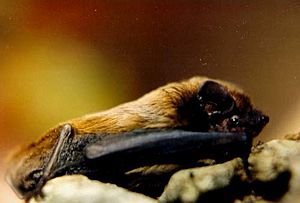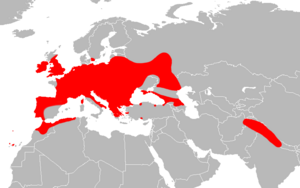Lesser noctule facts for kids
Quick facts for kids Lesser noctule |
|
|---|---|
 |
|
| Conservation status | |
| Scientific classification | |
| Genus: |
Nyctalus
|
| Species: |
leisleri
|
 |
|
The lesser noctule is a cool bat also known as Leisler's bat or the Irish bat. Its scientific name is Nyctalus leisleri. This bat is an insect-eater, meaning it loves to munch on bugs! It belongs to a big family of bats called vesper bats. The bat was named after a naturalist named Johann Philipp Achilles Leisler.
Contents
What Does the Lesser Noctule Look Like?
This bat is a medium-sized animal. It's a bit smaller than its cousin, the common noctule. From head to body, it measures about 48 to 68 mm long. Its wings can spread out from 260 to 330 mm wide! That's almost as wide as a skateboard.
The lesser noctule weighs between 11 and 20 grams. That's about the weight of a few coins. Its face, ears, and wings are dark. Its fur is brown, and it's darker near the skin than at the tips. This is different from the common noctule's fur. The fur under its arms is quite hairy. This is why some people call it the "hairy-armed bat"! Its ears are short and round. Inside the ear, there's a small, mushroom-shaped part called a tragus. Its wings are long and thin, perfect for fast flying.
Where Do Lesser Noctule Bats Live?
You can find the lesser noctule in many places. They live across Europe and western Asia. Their range goes all the way to the Urals mountains and the Himalayas. They also live in north-west Africa, the Canary Islands, and Madeira. There's a special type of lesser noctule in the Azores. Some scientists think it might be its own species, called the Azores noctule.
These bats usually live in forests. They like both pine forests and forests with trees that lose their leaves. But they are also good at living near people. You can find them in parks and even in cities. They often make their homes, called roosts, in buildings.
In most places, the lesser noctule is quite rare. But in Ireland, it's very common! It's the biggest and third most common bat species on the island. Because there are so many lesser noctules in Ireland, the country is considered their most important home in the world. In Britain, you can find a few groups in England and Wales. Sometimes, a bat might fly as far as Scotland.
Sadly, these bats face some dangers. There are fewer large insects for them to eat. They are also losing their forest homes and hollow trees. Chemicals used to treat wood in buildings can also be harmful to them.
What Do Lesser Noctule Bats Eat?
Lesser noctule bats come out to hunt soon after the sun sets. They love to eat flying insects. Their favorite snacks include moths and beetles. They fly very fast and straight, with quick, shallow dives. They often fly high, near the tops of trees.
Sometimes, you can see them flying around streetlights. They catch the insects that are attracted to the light. They are most active around sunset and sunrise. These bats can travel up to 10 km (about 6 miles) while they are looking for food!
Reproduction
Lesser noctules usually live in small groups when they have their babies. These groups, called colonies, often have about 20 to 50 bats. But in Ireland, these colonies can be much bigger! Some have as many as 1,000 bats living together.
Their homes are usually in hollow trees or inside buildings. Sometimes, they will even use special bat boxes that people put up for them. Female bats usually give birth to one or two young ones. Having twins is more common for bats living in the eastern parts of their range.
How Do Lesser Noctule Bats Use Echolocation?
Lesser noctule bats use echolocation to find their way around and hunt. This is like using sound to "see" in the dark. They make high-pitched sounds that humans can't hear. These sounds bounce off objects and come back to the bat.
The sounds they make are between 25 and 54 kHz. The strongest part of their sound is around 29 kHz. Each sound burst lasts for about 8.5 milliseconds. By listening to the echoes, the bat can tell where things are, how big they are, and how fast they are moving.



